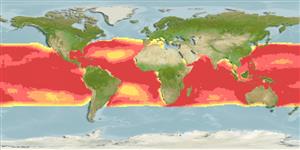Actinopterygii (ray-finned fishes) >
Perciformes (Perch-likes) >
Coryphaenidae (Dolphinfishes)
Etymology: Coryphaena: Greek, koryphaina = dolphin fish (Ref. 45335). More on author: Linnaeus.
Environment / Climate / Range
Ecology
Marine; brackish; pelagic-neritic; oceanodromous (Ref. 51243); depth range 0 - 85 m (Ref. 13608), usually 5 - 10 m (Ref. 40849). Subtropical; 21°C - 30°C (Ref. 26), preferred 28°C (Ref. 107945); 47°N - 38°S, 180°W - 180°E (Ref. 54341)
Atlantic, Indian and Pacific: in tropical and subtropical waters. Highly migratory species, Annex I of the 1982 Convention on the Law of the Sea (Ref. 26139).
Length at first maturity / Size / Weight / Age
Maturity: Lm 55.8, range 35 - 93.1 cm
Max length : 210 cm TL male/unsexed; (Ref. 9846); common length : 100.0 cm TL male/unsexed; (Ref. 3390); max. published weight: 40.0 kg (Ref. 30874); max. reported age: 4 years (Ref. 2885)
Dorsal
spines
(total): 0;
Dorsal
soft rays
(total): 58-66;
Anal
spines: 0;
Anal
soft rays: 25 - 31;
Vertebrae: 31. Greatest body depth in adults less than 25% of standard length; tooth patch on tongue small and oval; single dorsal fin extending from above eye almost to caudal fin with 58-66 rays; a concave anal fin extending from anus almost to caudal fin; pectoral fin more than half of head length (Ref. 10948). Caudal vertebrae usually 18 (Ref. 10998). Mature males posses a prominent bony crest in front of the head. The color is striking with golden hues on the sides, metallic blues and greens on the back and sides, with white and yellow on the underparts. Small specimens have pronounced vertical bars on the sides of the body.
Adults are found in open waters but also near the coast (Ref. 9293, 11230). Form schools. Feed on almost all forms of fish and zooplankton; also takes crustaceans and squid (Ref. 2850). Sexual maturity is reached in 4-5 months (3 for captive fish) (Ref. 11441). Spawn in the open sea and probably approximate to the coast when water temperature rises (Ref. 9293). Eggs and larvae are pelagic (Ref. 6755). Attracting devices such as floating bundles of bamboo reeds or cork planks are used to concentrate dolphin fish before the nets are set. Marketed frozen (Ref. 9987) and fresh and is of high value (Ref. 9293).
In East African waters, spawning season may last from March to early June and spawning occurs inshore. In the western Pacific, sex ratios were about equal during spawning season. Spawning in the western Atlantic occurs over an extended period of time.
Spawn naturally in captivity without artificial inducement (Ref. 41779).
Palko, B.J., G.L. Beardsley and W.J. Richards, 1982. Synopsis of the biological data on dolphin-fishes, Coryphaena hippurus Linnaeus and Coryphaena equiselis Linnaeus. FAO Fish. Synop. (130); NOAA Tech. Rep. NMFS Circ. (443). (Ref. 26)
IUCN Red List Status (Ref. 115185)
CITES (Ref. 94142)
Not Evaluated
Threat to humans
Reports of ciguatera poisoning (Ref. 30911)
Human uses
Fisheries: highly commercial; aquaculture: commercial; gamefish: yes
Tools
Special reports
Download XML
Internet sources
